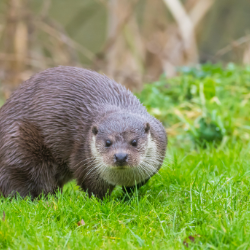Restoring Hardknott Forest in Cumbria
The Hardknott Forest restoration project is a bold and exciting initiative aimed at transforming a former commercial timber plantation into a thriving native broadleaf forest. In Cumbria, this project is helping to re-establish a 650-hectare site as a habitat for local biodiversity, with increased recording of otters, red squirrels, dormice, spotted woodpeckers, bullfinches, and jays.
Reviving the Land: From commercial timber to native woodland
The Hardknott Forest site was previously used by Forestry England to grow commercial timber, mainly non-native conifer species. However, the current project, run in partnership with the Forestry Commission, seeks to restore this land to its natural state by allowing native species to flourish. While much of the forest is being left to regenerate naturally, specific species such as juniper and hazel are being reintroduced to ensure a diverse mix of trees typical of the region’s original landscape.
Protect Earth, a key player in the project, has been instrumental in planting these native species to jumpstart the regeneration process. Along with tree planting, they are also planting native shrubs that would be the first to recolonise a site like this, further speeding up the process of succession—where ecosystems gradually develop and grow.
A collaborative effort: local volunteers and educational involvement
The restoration of Hardknott Forest is more than just an ecological effort—it's a community-driven project. Hundreds of local residents, schoolchildren, volunteers from the University of Leeds, and members of the John Muir Trust have dedicated their time to this effort. Volunteer days are open to everyone, offering an opportunity to get involved in forest restoration activities while learning more about the importance of preserving native woodlands.
Participants contribute to tasks like removing non-native trees, planting native species, collecting seeds, and protecting newly planted trees. It’s a hands-on way to help create more native woodland in Cumbria while enjoying the beauty of the Lake District.
Linking native habitats to boost wildlife
A key aspect of the project is its aim to connect Hardknott Forest with the Duddon Valley Woodlands — a series of ancient oak woodlands stretching from the forest down the valley to the Furness coastline. This connection will create a larger, continuous area of native woodland, which will further support wildlife and plant species by providing more extensive habitat.
The journey toward native woodland
The Hardknott Forest project is restoring one of the largest conifer plantations in the Lake District. Non-native trees are being gradually removed, making way for the return of native species like oak. Some areas are naturally regenerating, with species such as holly, willow, birch, and rowan already making a comeback. This, in turn, benefits native wildlife.
The restoration effort doesn’t aim to transform every corner of the forest—certain areas will be left as crags or bogs to support specific ecosystems. Rare mammals like dormice, otters, and red squirrels already live in the region, while bird species like great spotted woodpeckers, jays, and bullfinches are increasingly common. Ongoing wildlife monitoring is a critical and fascinating part of the project, helping conservationists understand the impact of the restoration.
Meaningful conservation backed by B-Corp businesses
The Hardknott Forest restoration project has drawn support from various organisations.
CapEQ Partner Mark Sapsford shared his thoughts on the project, saying: "We’ve been a net-zero business since day one, and while the nature of our work has a low environmental impact, we are always looking for meaningful, verifiable conservation projects to support our goal of doing business for good."
Thanks to the collaboration between the project’s leaders and partners like Ecologi, impactful volunteer-led conservation efforts are taking place in this beautiful corner of England.
Get Involved
Restoring Hardknott Forest is not only a journey to re-establish native woodland, but also a chance for individuals to make a tangible difference. Volunteers are always welcome to join in and help with practical restoration activities.
Whether it’s planting trees or monitoring wildlife, everyone’s contribution brings the project one step closer to its goal of restoring this stunning landscape for future generations.


